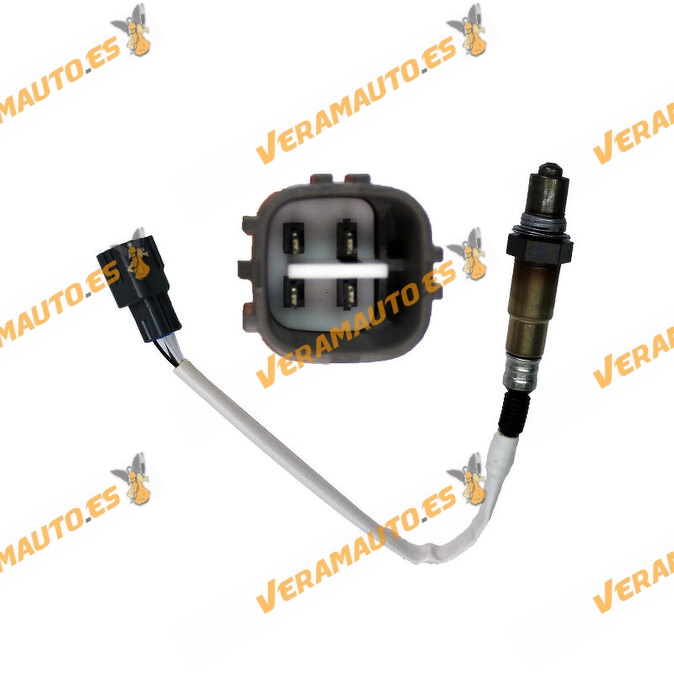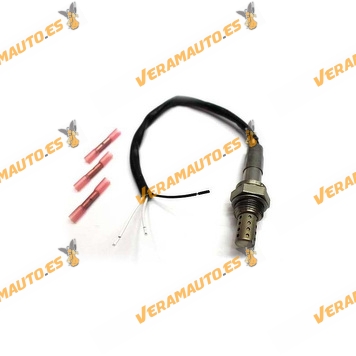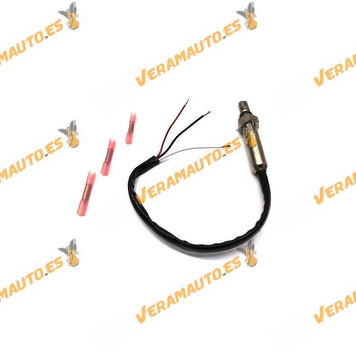Lambda Sensor Citroen | Peugeot | Toyota | 4 Pin Square Connector | Rear or Front Mount | OEM 894650D020
Do you need help ?
Line 1: 868 165 112
Line 2: 968 306 733
WhatsApp: 619 800 155
Remember to check reference OEM with your original autopart
You might also like
Product Description:
Citroen | Peugeot | Toyota | Toyota Lambda Sensor | Black 4 Pin Square Connector | Rear or Front Mount depending on model | OEM Similar to 89465-0D020
Voltage: 12v
Mounting Side: Front | Rear (depending on model)
Recommended Replacement Interval: 100,000 miles (160,000 km)
Terminal Type: Black 4 Pin Square Connector | Check model as this may vary depending on vehicle | Adapt Plug Connection if applicable
Cable Length: 230 mm
Compatible Models:
| Citroën | Año |
| C1 (PM_, PN_) 1.0 Berlina con portón | 50kW | 68hp | 3 Cyl. | Eng.CFA (384F), CFB (1KR) | 06/05-03/14 |
| Peugeot | |
| 107 (PM_, PN_) 1.0 Berlina con portón | 50kW | 68hp | 3 Cyl. | Eng.CFA (384F), CFB (1KR) | 06/05-05/14 |
| Toyota | |
| AYGO (KGB10_) 1.0 Berlina con portón | 50kW | 68hp | 3 Cyl. | Eng.1KR-FE | 07/05-05/14 |
| VITZ (SCP10_) 1.0 Berlina con portón | 50kW | 68hp | 4 cilindros | Eng.1SZ-FE | 02/03-01/03 |
| VITZ (SCP10_) 1.0 Berlina con portón | 48kW | 65hp | 4 cilindros | Eng.1SZ-FE | 03/03-09/05 |
| YARIS (SCP10_) 1.0 Berlina con portón | 50kW | 68hp | 4 cilindros | Eng.1SZ-FE | 02/03-01/03 |
| YARIS (SCP10_) 1.0 Berlina con portón | 48kW | 65hp | 4 cilindros | Eng.1SZ-FE | 03/03-09/05 |
Article no:
SL1025
Similar OEM part number:
1618-K9 | 1618K9 | 1618 K9 | 1618.K9 | 89465-0D020 | 89465-0D050 | 89465-0H020 | 894650D020 | 894650D050 | 894650D050 | 894650H020
Mounting Side:
Mounting Side: Front | Rear (depending on model).
Compatible Models:
Other Specifications:
Voltage: 12v
Mounting Side: Front | Rear (depending on model)
Recommended Replacement Interval: 100,000 miles (160,000 km)
Terminal Type: Black 4 Pin Square Connector | Check model as this may vary depending on vehicle | Adapt Plug Connection if applicable
Warranty:
1 Year Warranty Against Manufacturing Defect.
The images of our products may vary depending on the manufacturer, maintaining all the technical characteristics and compatibilities indicated in the product specifications.
Check the installation and use specifications according to the manufacturer's instructions.
With the use of a Lambda sensor in perfect condition, we will be sure to have:
Less pollution.
Better engine operation and performance.
Lower fuel consumption (Lambda sensors in poor condition can cause up to a 15% increase in fuel consumption).
No damage to the catalytic converter.
Check the correct functioning of the Oxygen Sensor at least every 30,000 km.
By means of the lambda sensor signal, the control unit recognises the composition of the mixture. The lambda sensor monitors the fuel-air mixture ratio and ensures that the engine operates at the optimum mixture, which is Lambda 1.
In over-fuelled or rich mixtures (Lambda <1), fuel injection is reduced, while in under-fuelled or lean mixtures (Lambda >1), the amount of fuel injected is increased until the optimum is reached.
It is recommended that after a major crash the Lambda sensors be checked or replaced.
The following steps must be followed to install the Oxygen Sensor:
Before installing the Oxygen Sensor, ensure that you are using the appropriate part number for your vehicle.
Do not install the Oxygen Sensor if it has been knocked.
Disconnect the battery. Disconnect the connector from the Oxygen Sensor to be replaced (the one located on the vehicle).
Remove the lambda sensor from the vehicle, making sure to leave enough cable for splicing if necessary.
Then, if it is a universal sensor, cut the wires from the removed lambda sensor, thus separating the connector from the rest of the lambda sensor.
Remove the insulation, according to the length indicated, taking care not to damage the metal core of the cable.
Insert the stripped wires from the connector into the bushings fitted to the new Oxygen Sensor, taking care to respect the colours of the wires.
Flatten the sleeves. Apply heat to the heat-shrink sleeve on the bushing to ensure that the connection between the recovered connector and the new sensor is correctly fixed and watertight.
Once the process described above has been completed, you can install the lambda sensor in your vehicle.
To check the correct operation of a lambda sensor, without removing it from the vehicle, we need an oscilloscope.
Bearing in mind that the engine must be adjusted within the manufacturer's specifications, we proceed to warm up the engine.
Connect, by means of the appropriate and specific connection system, the sensor output to the oscilloscope input, always without disconnecting the Lambda sensor from the car's ECU. Once these connections have been made, keep the engine at around 2,000rpm. Under these conditions, if the Lambda sensor is working correctly, the signal shown on the oscilloscope will vary rapidly and constantly between 0.2 volts (lean mixture) and 0.8 volts (rich mixture).
Another very important fact that must be taken into account is the time taken to change from one voltage to another, which should be about 300 milliseconds.
The time taken to switch from lean to rich and from rich to lean should be the same or very similar. If the signal generated by the sensor is constant or the reaction time to the change in richness of the mixture is too slow, the lambda sensor must be replaced. It is advisable to check the operation of the lambda sensor every time the engine is adjusted and always before emissions testing. Remember that slow lambda sensor operation directly affects the vehicle's fuel consumption, so the cost of replacing the lambda sensor will be quickly amortised.
- Replacement parts category
- Exhaust pipes and combustion
- Kind of replacement part
- Sounding line Lambda
- Mounting Side
- Rear
- Mounting Side
- Front






